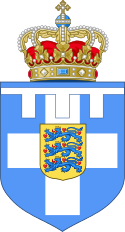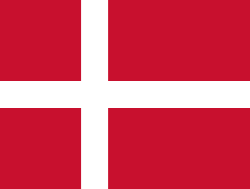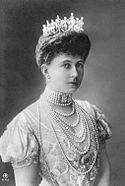Royal Arms of Greece (1936-1967)
- Royal Coat of Arms of Greece.svg: Sodacan
- derivative work: Sodacan (talk)
- Arms of Greece under the Glücksburg dynasty, created after the restoration of King George II to the throne in 1935, to the exile of King Constantine II in 1967 and finally until the abolition of the monarchy in 1973.
- The Escutcheon features the white cross on a dark blue field of Greece. The Inescutcheon features the Arms of the House of Schleswig-Holstein-Sonderburg-Glücksburg. The shield is then topped with a golden Royal Crown.
- It features an escutcheon divided by the red and white cross of the Order of the Danneborg, the first quarter features the arms of Denmark (three crowned blue lions and nine hearts in yellow field). The second of Schleswig (two blue lions passant in yellow field). The third divided into four; the chief features the three royal crowns in blue field of Sweden, the second half with a crowned stockfish on red field of Iceland and the last half divided between the ram of the Faroe Islands and a polar bear of Greenland, both on blue fields. The fourth quarter is divided between two halves, the chief depicts the blue lion passant over nine hearts of Jutland on a yellow field or the King of the Goths, the lower half depicts a crowned golden lindorm on a red field of the King of the Wends.
- Upon it is another inescutcheon in red, divided into four quarters: the first a a silver nettle leaf of Holstein, the second the a swan with a golden crown of Stormarn, the third a knight dressed in golden armor on a silver horse of Dithmarschen and the fourth of a golden horse's head of Lauenburg. Upon it is another inescutcheon divided the first features the red and yellow bars of Oldenburg, the second a golden cross on a blue field of Delmenhorst.
- The motto of the Coat of arms and of the dynasty, depicted on a golden ribbon below the pedestal reads: "Ἰσχύς μου ἡ ἀγάπη τοῦ λαοῦ" or "The people's love, my strength"
Relevantní obrázky
Relevantní články
Anne-Marie DánskáAnna Marie, princezna dánská, titulární královna řecká, je rodem dánská princezna a sňatkem řecká královna. .. pokračovat ve čtení
Jiří I. ŘeckýJiří I. Řecký byl v letech 1863–1913 řecký král z dynastie Glücksburgů, vedlejší linie Oldenburgů. .. pokračovat ve čtení
Frederika HannoverskáFrederika Hannoverská byla od 1. dubna 1946 do 6. března 1964 jako manželka krále Pavla řecká královna. .. pokračovat ve čtení
Pavel I. ŘeckýPavel I. Řecký byl v letech 1947–1964 řecký král. .. pokračovat ve čtení
Sofie PruskáSofie Pruská byla v letech 1913 až 1917 a v letech 1920 až 1922 jako manželka krále Konstantina I. řeckou královnou. .. pokračovat ve čtení
Konstantin II. ŘeckýKonstantin II. Řecký byl v letech 1964–1973 král Řecka. Nastoupil na trůn po smrti svého otce v roce 1964 a vládl de iure do roku 1973, kdy ho vojenská junta svrhla a vyhlásila republiku, de facto však vládl jen do roku 1967, kdy opustil Řecko. Stal se šestým a posledním králem Řecka z dynastie Glücksburgů, vedlejší linie Oldenburgů. .. pokračovat ve čtení
Pavel Řecký a DánskýPavel Řecký a Dánský je řecký titulární král, syn posledního řeckého krále Konstantina II. a královny Anne-Marie, která je rodem dánská princezna. .. pokračovat ve čtení































